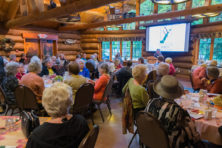Employment and the Philanthropic Community
- Share
- Tweet
- Pin
- Share
The question of employment — too much or too little — is multi-faceted and complex with a plethora of moving parts. It’s affected by really large, global forces (think the retirement of Baby Boomers) and smaller local forces (like the success of the Door County Visitor Bureau in growing our tourist economy or the newly formed Community Opportunity Investment Network in helping small, underfinanced ventures).
One could argue that with employment, it’s either feast or famine. If there is a “sweet spot,” an optimal unemployment rate that serves both employees and employers well, it’s difficult to find and hard to maintain. And this may be even more of an issue for Door County, a place both “blessed and cursed,” in the words of Door County Economic Development Corporation (DCEDC) Economic Development Manager Sam Perlman, by its geography. He’s not the first to point out that a small, rural county surrounded by water with a population that vacillates greatly between the 4th of January and the 4th of July might be a unique microclimate in the broader economic environment.
When the economy is growing and the workforce is aging, there are too many jobs for too few workers. This scenario, which we are under right now, creates stress. “Help Wanted” signs are everywhere, staff is overworked and the quality of the workforce is compromised. On the other hand, when the economy is stagnant and there are too few jobs to be had, a different kind of stress is felt by unemployed or underemployed workers and their families.
The Role of Philanthropy
The philanthropic community plays a large roll in mitigating the effects of the employment rollercoaster. And while it’s tempting to think that one organization or agency could provide the kind of leadership necessary to smooth out the ride, the answer is more nuanced; a wide variety of nonprofit, philanthropic and community-supported governmental agencies provide leadership in different ways at different times.
When work is unavailable or substandard in some way, our community relies more heavily on philanthropic organizations such as We Are HOPE, Inc., Lakeshore CAP, Feed My People, Wisconsin Home Energy Assistance, Habitat for Humanity, JAK’s Place, and others. They are the ones that keep body and soul together.
Beyond meeting the immediate needs related to food and shelter, we turn to nonprofit and publicly supported organizations such as the Door County Job Center, Northeast Wisconsin Technical College and Bay Area Workforce Development Board to prepare us for future, higher-paying, more secure jobs.
And then there are the philanthropic organizations that help the economy in a more general way by making Door County a culturally and environmentally rich, interesting and appealing place to live, visit, raise a family, or locate a business. The Door County Land Trust, Third Avenue Playhouse, Peninsula School of Art, Steel Bridge Songfest, Birch Creek Music Performance Center, Northern Sky Theater, The Hardy Gallery all come to mind, and there are many, many more. Stir all of these and other philanthropic acronyms together — DCEDC, NST, DCLT, BAWDB, FISC, DCCF, NWTC, COIN, DCWF, TNC, EHF, TPAC, etc. — and you’ve got a pretty hefty, flavorful and nourishing pot of alphabet soup.
According to the Door County Community Foundation (DCCF), there are more than 350 charities, associations, service clubs and other citizen groups working year round to positively impact the quality of our lives, and to create jobs.
In 2010, the DCCF reviewed tax records and found that the annual revenue of all of Door County’s nonprofit organizations was nearly equal to the annual revenue of all the hotels, resorts, bed and breakfasts, restaurants, diners, bars and taverns in Door County combined.
According to DCCF President and CEO Bret Bicoy, “Given the amount of revenue generated by our local charities, the impact of their payrolls, the indirect impact of their spending in the community, and the audiences they draw into Door County, we extrapolated that charities are responsible for approximately 3,600 full-time equivalent jobs. That’s why we here at the Community Foundation strongly believe that charity, or philanthropy, is a major component in the Door County economy.”


